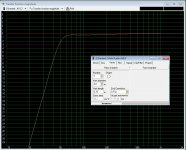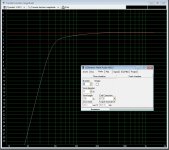OK I bit the bullet and took advantage of the Madisound sale on a pair of Alpair 10.3 m. Lucky me I've got a pair of boxes made out of some marble like material that I can repurpose for these. The box material is .5 inch and out side dimensions are 10x10.75x12. Looks like probably 16 liter net interior. My plan is to use this in my office without subwoofer. I intend to line the interior with a combination of butyl and felt. No idea if I should put any stuffing in there or not. From what I have read bass reflex should work well and the driver and port would bring the volume to just about 15 liter. But what port size? I am thinking to get the dual flare precision port as I have read the flares will limit or even eliminate chuffing. Considering that once in awhile I like to crank it up would anyone out there have suggestions for port sizes? 2" x 6" seems a good match for this application. But I'm sure there are others with more knowledge than I regarding ports and tuning. Also any thoughts on front, rear, or bottom firing? Placement in the office is flexible enough I could do any of these. Your comments are welcome. 🙂
There's a couple of designs on Mark's site
Alpair 10 Gold | Markaudio
The Golden Ratio BR is pretty damned close to that net volume, and uses a simple round port. To be honest, I've never been able to hear the difference between a flared and straight port on a FR operating at the SPLs to which I normally listen. I've not built or heard a pair of these.
There's also Dave's http://p10hifi.net/FAL/downloads/CGR-MarKen103p-plan-040414.pdf - with his "signature" slot ports. These I've done, and they certainly work.
Alpair 10 Gold | Markaudio
The Golden Ratio BR is pretty damned close to that net volume, and uses a simple round port. To be honest, I've never been able to hear the difference between a flared and straight port on a FR operating at the SPLs to which I normally listen. I've not built or heard a pair of these.
There's also Dave's http://p10hifi.net/FAL/downloads/CGR-MarKen103p-plan-040414.pdf - with his "signature" slot ports. These I've done, and they certainly work.
Anyone with WinISD could help you out with tuning. I'm at work, so can't help at the moment.
jeff
jeff
Thanks I was looking at those too but wasn't at all clear to me what the port tuning was.
While I don't think there was a notation on the drawings, I believe they were by Scott L? He does have a pretty good handle on such things, but doesn't always look for the accreditation he deserves.
I can wait to order a port until I get a little more feedback. Also given the way the existing box is I think I better stick to a round port, probably flared. Again it I'm completely open to options for front, back, or bottom mounted. I was also looking at the No-Rez material for lining the insides. Has anybody worked with this stuff? GR Research sells it and seems to think very highly of it. Maybe it's better than the butyl and felt combination I was thinking of.
Considering that once in awhile I like to crank it up would anyone out there have suggestions for port sizes? 2" x 6" seems a good match for this application.
That actually might be a good place to start. Here's a plot with a slightly shorter vent (5.75").
jeff
Attachments
Ok I think I need some experienced advice here...I read somewhere that tuning the port box resonance should equal the Fs driver resonance. Not sure if that is true or the best or not. The Alpair 10.3m is listed as 38.266Hz. Should I try and use this? Any thoughts on how that tuning would relate to the box Q. On Q I read that in a sealed box .707 is flattest response but that closer to .5 is best transient response. Not really sure how all this relates to box tuning for a bass reflex but hey maybe someone out there can enlighten me. Thanks for everyone's input so far.
In some cases Vb = Vas, Fb = Fs makes for a good baseline alignment, although it's not invariably appropriate.
As far as tuning reflex boxes in general goes, it's to a large extent circumstance and volume dependent. In most cases unless you have very specific goals and know exactly what you're doing & why, maximally flat alignments are best avoided unless you can easily alter the tuning. I often do max-flat alignments for forum use, but on the understanding it's a known baseline only & will almost certainly need adjusting for best results in practice.
As far as the 10.3 goes, 16 litres tuned to about 42Hz should do a reasonable job and be fairly flexible if you need to adjust a bit to suit your room / system.
As far as tuning reflex boxes in general goes, it's to a large extent circumstance and volume dependent. In most cases unless you have very specific goals and know exactly what you're doing & why, maximally flat alignments are best avoided unless you can easily alter the tuning. I often do max-flat alignments for forum use, but on the understanding it's a known baseline only & will almost certainly need adjusting for best results in practice.
As far as the 10.3 goes, 16 litres tuned to about 42Hz should do a reasonable job and be fairly flexible if you need to adjust a bit to suit your room / system.
Thanks to everyone for the recommendations. Somewhat for aesthetic reasons I am inclined to have the port on the bottom and give the speaker a two inch clearance. Certainly the clarity of sound, and imaging are paramount. Any thoughts on front vs rear vs bottom port placements, or even up firing to the ceiling? Remember these are bookshelf size and will sit on a counter top but I have about a one foot clearance to the rear.
Unless specifically modelled for close boundary loading, I'd be inclined to give far more than 2" of clearance regardless of where the ports are located. Certainly one of the advantages of front venting is that that will never be an issue.
Scott, et al?
Scott, et al?
Certainly one of the advantages of front venting is that that will never be an issue.
+1. Here's another sim with a 7.5" long port that gives ~42Hz box tuning, just for reference:
jeff
Attachments
Scott - is that your DNA on those BR boxes on Mark's site?
It might be -to be perfectly honest, I can't remember.
Re down-firing vents, they work (or can work) well for floorstanders if you make sure you've got enough adjustability built into them to tailor the height & how much damping is applied between floor / plinth & the vent. The same in theory could be said for standmounts, but it depends on what they're sitting on. If it's a counter top & you're happy to adjust the spacing then down-firing would probably be OK.
One point I'd note: for normal vented box alignments, I generally set a (not quite) arbitary maximum permissible total duct length of 6in assuming cylindrical or any other type of vent that does not have an extreme aspect ratio. If you need more, it may be advantageous to drop a duct size. Ducts are 1/2 wave resonators, so the higher you can shunt that, the less likely it is you'll have problems. Onken boxes often run into this issue & need some vent damping to kill the unwanted resonances (unless you like the effect). Obviously this needs to be traded off against air velocity within the vent, but in most cases it's possible to get the length down to a reasonable point without excessive velocity, and the latter can often be eliminated as an issue by down or rear-firing duct positions.
Last edited:
You guys are great thanks so much for the good advice, charts and all! So I will go with the 42Hz tuning and a little smaller vent so I can keep the port length below 6 inches. I'm not sure how to calculate vent velocity but a 1.375 ID x 3 inch port gets me the 42Hz tuning. Is that too small will it make noise? With Chris and Vinylkid's advice I'll forgo the idea of a bottom port. The one thought I still have on front versus rear is that the port output is out of phase with the driver output and if too close to the driver I have read that this can have some odd interactions, so that makes it seem that rear porting would be best, but then that might rob the room of some of the bass energy so still trying to understand what would be best. I am really looking forward to getting the best out of these speakers and hopefully have that speaker disappearing act and just the performers in the room. (I can dream can't I?) PS: I ordered the No-Rez and a friend donated some Edison Price music posts for terminals. Thanks for all your help!
So I will go with the 42Hz tuning and a little smaller vent so I can keep the port length below 6 inches.
I would stick with the 2" dia. port. If you can attach it so that it's removable, you could do a little experimenting with tuning.
jeff
Hmm well interesting to try and make the right set of choices. Truth is I do like to turn it up now and then and have some fun. Probably I'm just the kind of listener that the "arrestor" circuit was planned for - protects the driver when I try to boogie too hard. So I will do some searching for the right port size, flare - or no flare compromise. And before I start cutting into the box here is another question I have no idea if it makes sense or not - what about those scan speak aperiodic vents? Does one of those in a sealed box make any sense at all for this driver and this size box? Seems very difficult to find specific guidelines for using those vents. Thanks again for everyones input. By the way I think the boxes are made of a material called Corian.
- Home
- Loudspeakers
- Full Range
- Alpair 10.3 bass reflex


